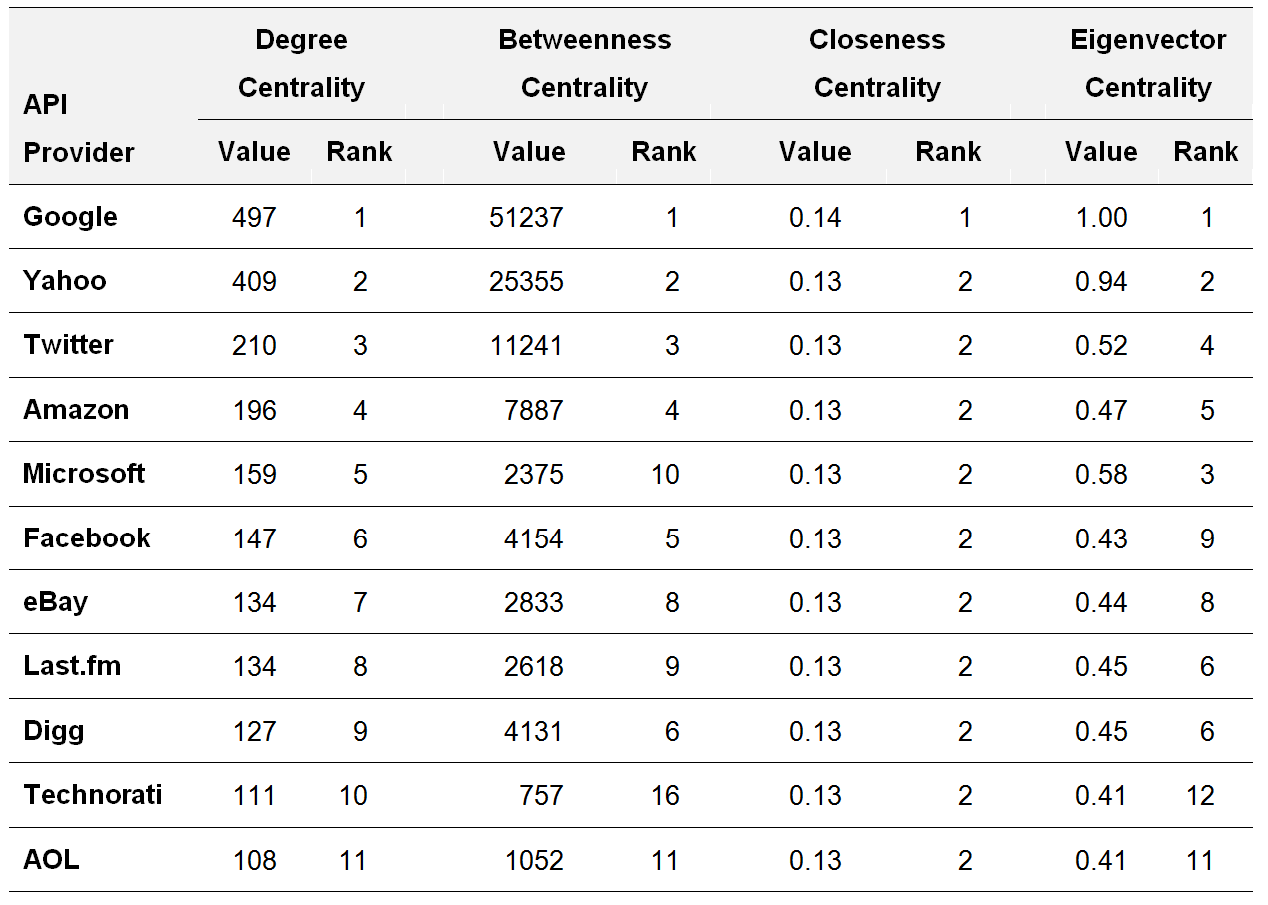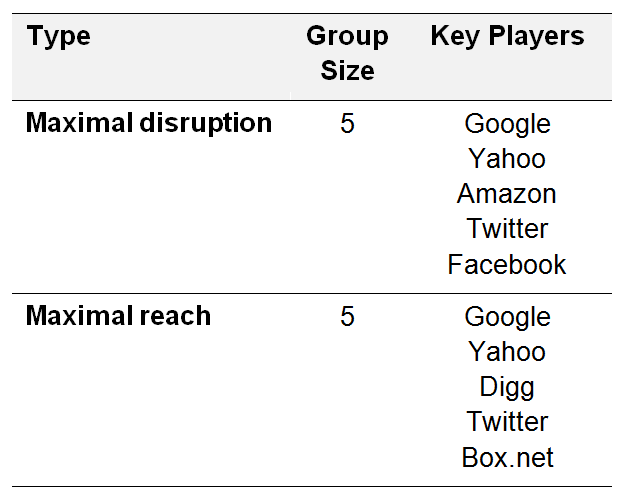“A leader needs enough understanding to fashion an intelligent strategy.”
John Kotter
Abstract
By combining multiples sources of data to create a new application, mashups represent a powerful source of innovation. Together, the various data providers, developers, mashup platforms, and users constitute an ecosystem that depends on innovation from these various players for its growth and success. This article summarizes recent research into the network structure of the mashup ecosystem, along with the positions and roles of entities within it. This research illustrates analytical methods for identifying key players in an ecosystem, while delivering new insights into the structure of the mashup ecosystem. Finally, the implications of these findings for entrepreneurs and incumbents are discussed.
Introduction
To succeed in innovative markets, companies need to make decisions based on an accurate understanding of the structure and organization of their business environment. Mapping and characterizing a company’s business environment will help companies understand their position and the position of other companies in that environment. For incumbents, this information allows them to adjust their business strategy in response to changes in the environment. For new entrants, characterizing a business environment is essential when developing innovations to suit that environment. The objective of this paper is to describe recent research into the structure of the mashup ecosystem and methods of identifying key players within it.
The Mashup Ecosystem
Facilitated by the evolution of Web 2.0, the mashup ecosystem grew and evolved through interactions between data providers, developers, mashup platforms, and users (Weiss and Gangadharan, 2010). A mashup is a custom web application that uses various data sources to create and deliver new services. Data providers offer developers access to their data via application programming interfaces (APIs). Using these APIs, developers are able to query the data and build mashups that combine data from multiple APIs (Yu and Woodword, 2009). Examples of API providers include Google and Yahoo, who release data through the Google Maps and Yahoo Search APIs, which can be used by independent developers to create mashups.
The mashup ecosystem relies on innovation for its growth and success. The ecosystem is supplied with raw ingredients through data and APIs, and the Internet provides the environment to support the creation of new applications by developers (Fichter, 2009). The mashup ecosystem is unique because its growth is strongly influenced by independent players. Even though API providers supply the data and the tools to access the data, they are not the major driving force for mashup development. That process lies in the hands of developers.
Research Design
As part of the author’s recent Master’s degree in the Technology Innovation Management program at Carleton University in Ottawa, the mashup ecosystem was studied to identify its key players.
The first step in analyzing the mashup ecosystem was to represent two networks within it: i) the API affiliate network, which captures the relationships between mashups and APIs; and ii) the API provider network, which captures the relationships between mashups and API providers. The API affiliate network represents linkages at the API level within the ecosystem, while the API provider network reflects these linkages at the provider level and therefore represents the ecosystem at the firm level.
The API and mashup data used to establish the structure of these networks were manually extracted from the ProgrammableWeb, one of the largest online repositories of mashups and APIs. The extracted data included mashups created between September 2005 and August 2010.
Once the API affiliate network and API provider networks were established, four distinct methods of network analysis were applied to these networks. These techniques examined different structural and positional properties in the two networks and identified key players in each. Descriptions of each type of analysis and their key findings are provided in the sections that follow.
Network Centrality Measurements
These techniques identify core and central entities in an ecosystem. Centrally located nodes have a more strategic and important position in the network and have faster access to information and resources. Thus, centrality indicates the extent to which a node’s strategic position is defined by its strategic ties to other nodes in the network (Gnyawali and Madhavan, 2001). The types of centrality measurement used in this research were degree centrality, betweenness centrality, closeness centrality, and eigenvector centrality.
The results confirmed that a provider’s status is dependent on the specific centrality measurement being considered. Each of the different centrality measurements will identify central nodes in the network based on the network position examined by the measurement. The centrality measurements revealed a similar set of API providers that hold prominent position and influence in that network. However, the rank and importance of those providers shift dependent on the centrality measurement, as shown in Table 1.
Table 1. Centrality Measurement Results for API Providers
Community Detection Algorithm
This algorithm identifies communities of nodes within a network (Girvan & Newman, 2002). Communities are sub-networks of nodes that are more densely linked internally than they are with the remainder of the network. In the mashup ecosystem, these communities can be described as collectives, because the connectivity of nodes is driven by user innovation rather than company alliances and associations.
The results of this analysis revealed that the mashup ecosystem is centered on a core collective of 45 API providers that contribute to the ecosystem through the release of APIs that are frequently used together in mashup development. The formation of this core collective of providers is driven by developers that deploy those APIs in mashups. Prominent API providers in the core collective are 12seconds.tv, 43Things, Amazon, AOL, eBay, Google, Microsoft, Technorati, Wikipedia, and Yahoo. In addition, the community analysis revealed that there are multiple smaller collectives of API providers, consisting of members that do not belong to the core collective.
Key Player Problem
This methodology attempts to solve the problem of finding the key player in a network by focusing on two related sub-problems (Borgatti, 2003). First, it focuses on identifying the set of nodes that, if removed, would maximally disrupt communication among the remaining nodes in the network. Second, it focuses on identifying the set of nodes that are maximally connected within the network. In this way, Borgatti’s method identifies a set of key players in a network, rather than a single key player.
Analyses of the key player problem revealed two similar sets of API providers, as shown in Table 2. It is not surprising that Google and Yahoo belong to both sets of key players identified by the two algorithms because they release a large number of APIs into the mashup ecosystem. However, API providers like Twitter, Facebook, Digg, and Box.net release one API each yet they rank as one of the key players. The popularity of these specialiaed APIs is likely due to the nature of the data they provide and their general appeal to mashup developers.
Table 2. Results of Key Player Problem Analyses
Topological Importance Index
This technique measures a node’s importance on its direct and indirect neighbours. The effect of a node outside its immediate neighbourhood can be determined by measuring its influence on other nodes with a pre-defined distance.
The results revealed that API providers exert different levels of influence on their immediate neighbourhood. Also, some providers (such as 23, 12seconds.tv, and 43Things) show stronger levels of influence on more distant neighbours relative to other providers (such as Google, Amazon, and Yahoo). AOL maintains its positional importance, suggesting that they occupy a unique position in the network. One can speculate that companies like Google and Yahoo have many direct connections to other providers on the periphery of the network but have fewer non-direct connections to other providers. And hence, their influence is highest on their direct neighbours. Similar to what was observed in the API affiliate network, these providers gain importance due to their high eigenvector centrality measurements and their connections to more central providers in the network.
Implications for Entrepreneurs and Incumbents
Entrepreneurs and incumbents in the mashup ecosystem need to develop appropriate business strategies when releasing APIs. The success of these APIs is dependent on their appeal to mashup developers as they drive the development and growth of the mashup ecosystem. However, API providers should also consider the following implications of this research when developing their business strategy within the mashup ecosystem:
1. New entrants should consider releasing APIs that are compatible with the key player APIs. This may encourage developers to use the entrant’s API when developing mashups. The community detection algorithm identified a core collective of APIs that are closely linked due to their frequent usage in mashups. Developing APIs that are complementary to the APIs in the core collective may increase the chance of success in the mashup ecosystem.
2. This research can help incumbents and entrepreneurs when developing business strategies in the mashup ecosystem. As suggested by Weiss and Gangadharan (2010), new entrants can follow or complement the strategies of key players to achieve successful entry into the ecosystem. This is also true for incumbent providers who are looking to improve their position and their role within the ecosystem.
3. An API’s influence and reach in a network is dependent on the position and centrality of its neighbours. Certain APIs and API providers have strong influence based on their connectivity to high-ranking providers. Entrepreneurs and incumbents should develop APIs that are compatible with high-ranking providers to improve their position and influence within the mashup ecosystem.
Conclusion
The mashup ecosystem is a unique business ecosystem as it is dependent on innovation from users (independent developers) for its growth and success. The research described in this article examined this business ecosystem to identify its key players. The findings from this research can help incumbents and entrepreneurs develop business strategies as API providers in the mashup ecosystem.


